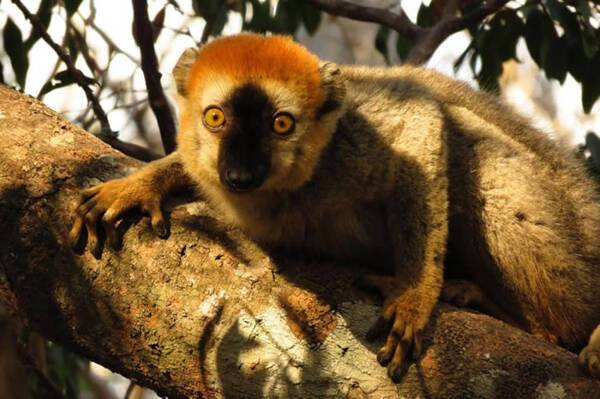Eulemur rufus
IUCN
LCBasic Information
Scientific classification
- name:Eulemur rufus
- Scientific Name:Eulemur rufus,Red Brown Lemur,Red-fronted lemur
- Outline:Primates
- Family:Lemuridae Lemuridae
Vital signs
- length:35-48cm
- Weight:2.2-2.3kg
- lifetime:20-25years
Feature
Use poisonous millipedes as ointment
Distribution and Habitat
The Red-fronted Lemur is found in two different populations in eastern and western Madagascar. The eastern and western populations represent two different subspecies, but these have yet to be confirmed by the authorities. There is a small population introduced in southern Madagascar.
The Red-fronted Lemur inhabits dry tropical lowland forests and tropical wet lowlands; in eastern Madagascar it is found in montane forests. The Red-fronted Lemur is a highly arboreal species, spending most of its time in the upper levels of the forest.
Appearance
The red-fronted lemur is 35-48 cm long, with a tail length of 45-55 cm and a weight of 2.2-2.3 kg. The tail is longer than the body, with dense and long tail hair, mostly in the shape of a broom; the eyes are large; the fur is dense and brightly colored; the snout of large species is elongated, shaped like a fox's mouth; the external ear shells are semicircular, or densely furred; the hind limbs are longer than the forelimbs, with flat nails on the fingers and toes, and smaller species have a grooved and curved claw on the second toe; there are 36 teeth, but the upper incisors are missing.
Details
Red Brown Lemur (scientific name: Eulemur rufus) lives in small groups, usually 8-10 individuals. Although the body shape and limb structure of lemurs are similar to monkeys, their faces are similar to those of foxes and dogs. They like to bask in the sun because they are afraid of the cold. When basking in the sun, their backs are arched, much like a squirrel, stretching their arms and legs to enjoy the warmth of the sun. They are gentle and like to be clean. They use their claws to comb their fur every day.

When the red-fronted lemur jumps from a tree to the ground to find another tree to live in in order to escape from enemies, find food, or for other reasons, the difference between it and monkeys can be clearly seen, because the lemur will bend its body first and then jump continuously during the movement.
The mating season of the red-fronted lemur is from September to October. The female monkey has a gestation period of 120 days. Usually, one baby is born per litter, and occasionally two babies are born. The baby monkey is naked and hairless when it is born. The mother monkey either carries the baby on her back or in her arms and lives together. It reaches sexual maturity at the age of 2-3. The life span of wild lemurs is 20-25 years old.
Listed in the 2012 Red List of Endangered Species of the World Conservation Union (IUCN) ver 3.1 - Vulnerable (VU).
Listed in the CITES Appendix I of the Washington Convention as a protected animal.
Protect wild animals and eliminate game.
Maintaining ecological balance is everyone's responsibility!








